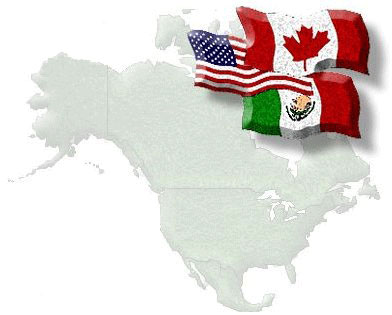Part 2: North America Free Trade Agreement (NAFTA)

Source: www.dfait-maeci.gc.ca/nafta-alena/ nafta10-en.asp
Overview of NAFTA
The best way of identifying what NAFTA is trying to accomplish is from the authors of the document itself. The following is a listing of goals as set forth in the preamble of the NAFTA agreement.
- To strengthen bonds of friendship and cooperation.
- As a catalyst to international cooperation.
- To create, expand, and secure future markets.
- To establish fair rules of trade.
- To ensure a predictable framework for business planning.
- To enhance firms competitiveness in foreign markets.
- To foster creativity and innovation.
- To create new employment opportunities.
- To promote development.
- To strengthen environmental regulations.
The North American Free Trade Agreement (NAFTA) roots date to the passage of the Canadian-American Free Trade Agreement in 1989. The goal of this little noticed agreement was to create a free trade area along the American-Canadian border. In the early 1990s the two nations sought to expand this arrangement to include Mexico, and on January 1st of 1994, NAFTA began. The agreement called for a complete removal of trade barriers between the members within 15 years. There has been much debate among different interest groups and individuals over what the final impact of this agreement would be. Although the agreement includes the countries of the U.S. , Canada, and Mexico, nearly all of the debate in the U.S. has focused on the issue of trade with Mexico.
Proponents of NAFTA
Those in favor of NAFTA included most economists, nearly all multinational corporations, and several key political figures, including Presidents George Bush and Bill Clinton. Economists favored the agreement because it fit well with the efficiency gains predicted by their free trade models. Multinational corporations were attracted to the expected improvements to the "bottom line." Presidents Bush and Clinton both believed the gains from lower prices for American consumers and job creation in American export industries outweighed the job losses associated with increased import competition and corporate relocation, particularly if job retraining opportunities were put in place.
Opponents of NAFTA
Those against NAFTA included labor unions, environmental groups, anti-globalization activists, and many political figures, including Pat Buchanan, Richard Gephardt, and many other members of Congress. U.S. labor unions feared wage and benefit reductions as well as complete job displacement due to corporate America's increased access to the Mexican labor force. Environmentalists envisioned severe environmental degradation in Mexico, where environmental laws are weak and often not enforced. They also predicted a weakening of America's present environmental laws in the name of staying competitive with Mexico. Many of the political figures who most strongly opposed NAFTA were from constituencies dominated by manufacturing-based employment.
AUDIO: Click here to listen to Pat Buchanan's thoughts on NAFTA.
To appease the fears of NAFTA opponents, there were "side agreements" made on environmental and labor rights issues. Three institutions were created to address these concerns: The Commission on Environmental Cooperation (CEC), the Border Environmental Cooperation Commission (BECC) and the North American Development Bank. Additionally, a NAFTA Trade Adjustment Assistance Program was created to compensate displaced
American workers.
Beyond NAFTA
Since the introduction of NAFTA, there have been calls for its expansion to include all of the Americas. These plans were launched publicly in 1994 at the Summit of the Americas in Miami, Florida. This summit was hosted and wholeheartedly endorsed by President Clinton, who proposed the Free Trade Area of the Americas (FTAA) be implemented by January, 2005.
President George W. Bush and his administration also support the creation of a FTAA, and have recently endorsed the creation of a Central American Free Trade Agreement (CAFTA) as an intermediate step aimed at moving the process forward. On May 28, 2004, CAFTA was signed by the United States and five Central American countries. The Bush administration plans to present the deal to Congress toward the end of 2004. If approved, CAFTA would call for the elimination of tariffs between from the United States, Costa Rica, El Salvador, Guatemala, Honduras, and Nicaragua. Not surprisingly, the renewed discussion of further U.S. regional integration with its neighbors is stirring emotions across the political landscape in the same way NAFTA did in the early 1990s.
Additional Resources and Readings
There is a wealth of information available on the Internet that addresses the impact of NAFTA and the movement toward further regional integration in the Americas. Below are links to a variety of interesting readings, audio clips, video clips, and websites which should help you learn more about the issues and help you answer the discussion questions for this part of the unit.


